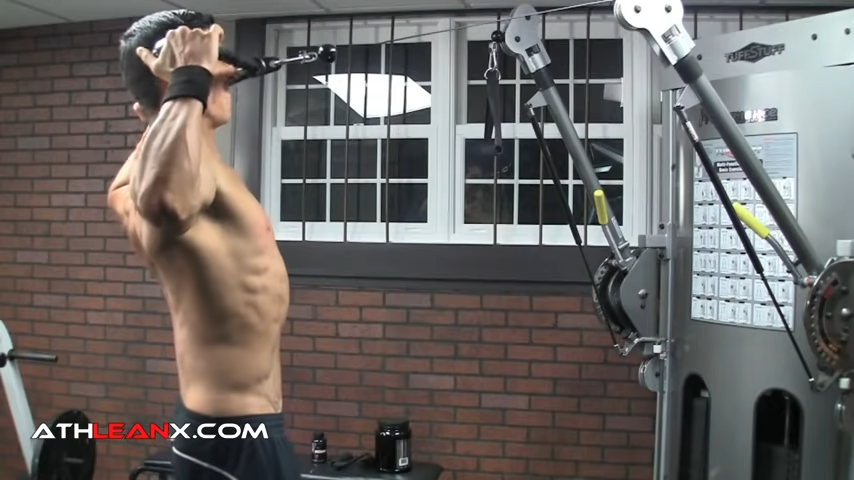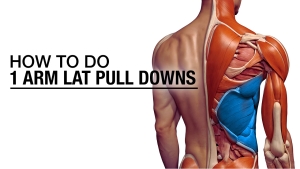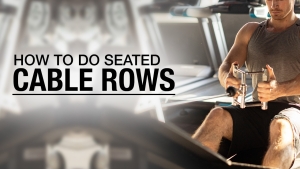
UPPER BACK WORKOUT
If you want to build a ripped, athletic-looking upper back–that area up around your shoulder blades–you need to not only work on width, but thickness.
I’m going to tell you how you can develop thick upper back muscles of your own for that three-dimensional look. Wide, AND thick. This will help give you that V-shaped torso, but also add some impressive volume in that area.
You might be thinking that your bigger compound lifts such as farmer’s carries, barbell shrugs or even deadlifts should be enough to build the upper back.
But the truth is, they don’t target the upper back muscles enough to build the thickness we’re talking about. You need to add in some exercises that support those bigger lifts and work to isolate the upper back muscles.
I’ll show you just two cable machine exercises that are enough to do the job. Add these to your back workouts, and you are sure to notice a difference in your upper back!
SUPPLEMENTING BIG COMPOUND MOVEMENTS
For starters, let me say that I think it’s important that you lift heavier weights to build the back.
Exercises like farmer’s carries, deadlifts, and barbell shrugs are popular movements associated with upper back development.
Big-time compound movements are very often used in strength training. But they use a lot of legs and supporting muscles along with the ones you’re trying to isolate, so it’s hard to determine exactly how much load your upper back is actually getting.
Strength and size are not always achieved the same way. You should have movements in your exercise program that directly work your upper back muscles.
You also need to target the upper back more directly, allowing you to focus on those muscles between, around, and above your scapulae (shoulder blades).
Below are the two key cable machine movements I recommend you do regularly to support those compound movements and laser target that upper back thickness.
UPPER BACK EXERCISE 1: FACE PULL
I love the Face Pull for upper and middle back, and I actually recommend you perform it after every workout.
In this article on face pulls, I promote them as the remedy for a common front to back imbalance that most of us have when we frequently train chest, triceps, shoulders or abs.
Here are five excellent reasons to work face pulls:
- The face pull provides excellent external rotation and scapula work to offset all that pushing work.
- The scapular stability it builds will provide greater support for pushing movements. A greater base of support your shoulders and upper back will provide for more pushing ability.
- Not only is the face pull an excellent movement to grow your upper back muscles, it can also improve poor posture. The rear shoulder muscles play a big role in preventing the bad posture so many people get from time spent sitting at desks jobs and hunched over their electronics.
- It’s one of the most effective exercises to strengthen the upper back, lower trapezius, rear deltoid and rotator cuff. Because the upper trap muscles extend to the skull, you’ll be working on your neck size in the process.
- You can do them anywhere! If you don’t have a cable machine or access to a gym, you can do Face Pulls on a pull-up bar with a regular piece of tubing or resistance band. There’s no excuse to not add these to your workout routine.
A lot of guys get this exercise wrong. They stop about halfway through the movement and lose the most effective part of the exercise, which is the end range of motion. You can learn the most common Face Pull mistakes in this article.
If the Face Pull is not already in your workout routine, start doing it now…but do it using correct form!
HOW TO DO A FACE PULL WITH PROPER FORM
Face pulls are frequently done with poor form. Proper form is crucial to getting the benefits.
From a standing position, use an overhand grip. Tighten your core muscles and pull the rope (band or tube) straight toward your face. Your hands will leave the center of your face and go out to the sides.
Using this shoulder-width grip, pull all the way to the sides of your head. This has two distinct advantages: greater range of motion, and engagement of the muscles you’re targeting.
Another mistake is incorrect elbow position. Don’t let your elbows drift down toward your chest.


Keep your elbows down and your hands up, so that your shoulders can externally rotate. This allows you to get maximum contraction on the rear deltoids, traps and rhomboids.
Posture should be erect; body should be as rigid as when doing a plank. Don’t move your torso forward and backward or bend at the waist. Doing so adds momentum and decreases the benefits of the Face Pull. Also, keep your neck neutral. Using a forward chin posture to meet the cable or resistance band reduces the range of motion.
Working on proper shoulder rotation provides additional stability to the rotator cuff muscles and guards against anterior and posterior muscle imbalances.


Guys, it’s not a good recipe for your shoulder health to keep your elbows high and internally rotated at the same time during a Face Pull. You still want to be sure that the shoulder muscles stay in functional balance.
KNOW YOUR SHOULDER ROTATION
The shoulder joint is complex. It’s composed of the scapulo-thoracic joint (where the shoulder blades join with the rib cage), the acromio-clavicular joint (collar bone and acromion process–the boney top part of the shoulder), and the glenohumeral joint (upper arm ball-and-socket joint).
This complex structure allows the shoulder to rotate in several planes of motion. This requires balance between front and back to avoid shoulder problems long-term.
A common problem these days is chronic internal rotation. Because we spend a lot of time training the chest, and hunched over our electronics with poor posture, our shoulders can become rounded. Our chest muscles are often stronger and more developed that the muscles of our rear shoulder muscles.
Weak muscles in the rear shoulders lead to poor posture and other muscle imbalances.
You can do a simple test to see if your shoulders are chronically internally rotated. Stand in front of a mirror, arms by your side. If you see the backs of your hands, your shoulders are internally rotated.
Using the exercises I’m sharing today that train external rotation and scapular retraction will help correct those imbalances and lead to healthier shoulders.
UPPER BACK EXERCISE 2: TRAP RAISE
The Trap Raise looks like a Front Shoulder Raise when viewed from the top, but it’s not an anterior deltoid movement.
This exercise works both the middle and lower traps and the upper traps, as well as rear shoulders.


USE YOUR BACK, NOT FRONT DELTS
Use a neutral grip so that your thumbs will be pointed back toward your head.
Start by holding the cables or resistance bands parallel to the ground. Don’t start from a low position, which will involve the anterior deltoids.
Now, tighten your core muscles, engage your upper back muscles, and pull all the way up and back toward your body until your arms are perpendicular to the floor. Effectively, your arms are moving from a zero to 90o angle.
Then, at the top of the range of motion, engage your upper traps to feel that squeeze, maintaining core control so that you don’t bend forward.
Concentrate on keeping the scapula firmly against your rib cage as your shoulders rotate upward to achieve a strong isometric contraction.
If you incorporate these two direct upper back exercises into your back training along with your focus on lifting heavier weights (like farmer’s carries, deadlifts, and barbell shrugs), you will notice much faster size gains in your upper back muscles.
Keep in mind that the face pull serves a double purpose as an awesome corrective exercise that will help correct existing imbalances, strengthen your rotator cuff muscles, and help you with your other upper body lifts.
If you’re looking for a complete program that will help you build size and strength in every muscle in the body, you’ve come to the right place! Check out our ATHLEAN-X programs to see which one best fits your goals and current fitness level.

- Building a bigger more impressive upper body isn’t just about making it wider, it needs to get thicker as well.
- Heavy lifts like farmer’s carries and deadlifts are important go-to exercises for upper back thickness, but they don’t do enough to laser target the upper back.
- Incorporating exercises that isolate the intended upper back muscles can get you to your physique goals faster.
- Two exercises that focus on the muscles all around your shoulder blades are the Face Pull and the Trap Raise. Both can be done using a cable machine, tubing, or resistance bands.
- A proper Face Pull uses an overhand grip and pulls the resistance band or cable all the way to the sides of the head. Poor form is common; use the correct form described.
- The Trap Raise starts with arms parallel using a neutral grip and ends with arms directly overhead. You can use a cable or band for this exercise.
- The key to both exercises is proper performance to isolate the target muscle groups while building the shoulder stabilizers and maintaining functional balance.
- Tighten your core muscles prior to each movement. Even though these exercises aren’t intended to develop core strength, core stability is important to perform these upper back exercises correctly.

Jeff Cavaliere M.S.P.T, CSCS
Jeff Cavaliere is a Physical Therapist, Strength Coach and creator of the ATHLEAN-X Training Programs and ATHLEAN-Rx Supplements. He has a Masters in Physical Therapy (MSPT) and has worked as Head Physical Therapist for the New York Mets, as well as training many elite professional athletes in Major League Baseball, NFL, MMA and professional wrestling. His programs produce “next level” achievements in muscle size, strength and performance for professional athletes and anyone looking to build a muscular athletic physique.


































